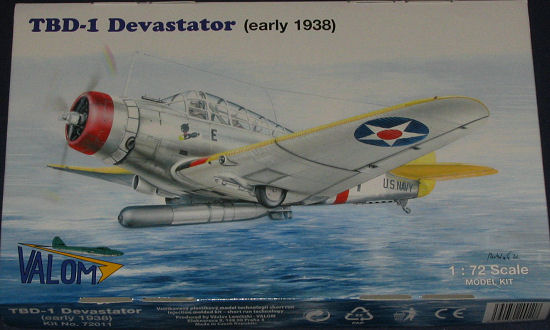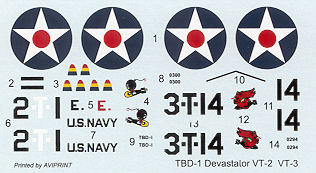
| KIT: | Valom 1/72 TBD-1 Devastator (1938) |
| KIT #: | 72011 |
| PRICE: | $ |
| DECALS: | Two options |
| REVIEWER: | Scott Van Aken |
| NOTES: | Short run with resin and photo etch parts |

| HISTORY |
The Douglas TBD Devastator was a torpedo bomber of the United States Navy, ordered in 1934, first flying in 1935 and entering service in 1937. At that point, it was the most advanced plane flying for the USN and possibly for any navy in the world. However, the fast pace of aircraft development caught up with it, and by the time of the Japanese attack on Pearl Harbor the TBD was already outdated.
The TBD Devastator marked a large number of "firsts" for the US Navy. It was the first widely-used carrier-based monoplane as well as the first all-metal plane, the first with a totally enclosed cockpit, the first with hydraulically folding wings; it is fair to say that the TBD was revolutionary. A semi-retractable undercarriage was fitted, with the wheels designed to protrude 10 inches (250 mm) below the wings to permit a "wheels-up" landing with only minimal damage.
A crew of three was carried beneath a large "greenhouse" canopy almost half the length of the airplane. The pilot, of course, sat up front; a rear gunner and radio operator took the rearmost seat, while the bombardier occupied the middle seat. During a bombing run, the bombardier lay prone, sliding into position under the pilot to sight through a window in the bottom of the fuselage. The offensive armament that he targeted would be either a single Mark XIII torpedo or a single 1000 lb (450 kg) bomb. Defensive armament consisted of either a .30 or .50 cal (7.62 or 12.7 mm) machine-gun firing forwards, and a .30 caliber (7.62 mm) machine gun for the rear gunner.
The powerplant was a Pratt & Whitney R-1830-64 Twin Wasp radial engine of 900 horsepower (671 kW).
129 of the type were purchased, equipping the carriers USS Saratoga, USS Enterprise, USS Lexington, USS Wasp, USS Hornet, USS Yorktown and USS Ranger.
| THE KIT |
 Departing somewhat from their regular offerings of unusual kit, Valom has decided that it is time for a modern TBD-1 Devestator in 1/72. The one most of us are used to is the now quite elderly Airfix kit. While it was not bad and offered the option of having folding wings, it is definitely time to have a modern, updated version.
Departing somewhat from their regular offerings of unusual kit, Valom has decided that it is time for a modern TBD-1 Devestator in 1/72. The one most of us are used to is the now quite elderly Airfix kit. While it was not bad and offered the option of having folding wings, it is definitely time to have a modern, updated version.
Valom's kit is very nicely molded with engraved panel lines as one expects from a new mold kit. Gone are the rivets that covered most of the Airfix kit. The corrugations are equally well done. Horizontal stabs are a single piece and look to be well done. I'm sure there will be the usual commentary about the ribbing effect of the flight surfaces, but a light sanding will reduce that if you think it is too much. Since this is short run, low pressure molding, the level of detail isn't as crisp as you'd find on high pressure kits from Revell or Tamiya, but it is quite good. The sprue runs into the parts will often go into the join areas so clean-up will be a bit more than the norm. The large parts have small ejector towers that will need to be removed prior to construction.
I found the plastic to be well done and my single concern is with the prop. One of the blades has a large sink area on it and the hub isn't really that well detailed. I'm not sure if Aeroclub has a replacement but it may be something to consider. You need at 10' 3" Hamilton Standard. The canopy is well molded with strong frame lines so masking should be easy. It is a bit on the thick side so seeing any detail in the cockpit area would be somewhat problematical. The cockpit is a single piece reaching from front to back so in order to show anything open, either you'll have to cut the canopy or look for a vacuform replacement.
Most of the detail parts are in resin, and this includes the complete interior, wheels, and cowling. The torpedo, a piece of ordnance designed just for this boxing, and its bay are also provided. Should you wish to show it without this weapon, a fuselage blanking plate is provided as having that large, open cavity in the lower fuselage would have caused the Devastator's already sedate  performance to deteriorate even more. The torpedo fins and props are in etched brass. The resin bits are, for the most part, well molded. I had a few fragile bits broken while jostling around in the bag and I found several air pockets in the cowling that will have to be filled, but overall it is well done.
performance to deteriorate even more. The torpedo fins and props are in etched brass. The resin bits are, for the most part, well molded. I had a few fragile bits broken while jostling around in the bag and I found several air pockets in the cowling that will have to be filled, but overall it is well done.
The cockpit/crew compartment is a single casting with the seats and consoles cast into it already. Basically, one just adds the etched belts and a few resin bits (like the aft gunner's position) to be ready to go. The kit's resin engine is well molded ad appears to be somewhat generic, but should be most convincing when painted and detailed. Instrument panels are etched brass with acetate instrument backings, something that always works out well. The rest of the build is pretty basic short run stuff with no alignment pins and butt joins the norm.
Valom's instructions have gone to that next step from their previous offerings. They are well printed on gloss paper with the cover and painting/markings guide in full color. The back page is specifically for a color chart that offers Humbrol, Agama, Model Master, Gunze, and FS 595 references. The construction steps are well draw n and, thankfully, the painting and part number blocks are much smaller so don't overwhelm the diagrams. A very nice addition is a well drawn three view. Markings are provided for two aircraft. Both are 'yellow wing' birds. The first is from the USS Lexington in 1938. This one has a full yellow tail section as well as red nose, fuselage, and wing bands. The modeler will have to paint these on along with the black wing walk areas. The second is from the USS Saratoga, also in 1938. This one is a bit more sedate with no tail colors, blue wing bands and a half blue cowl. Interestingly, this one does not show the normal wrap-under of the upper wing yellow. The decal sheet is very nicely printed by AviaPrint any my experience with these in past builds has been very positive. You'll notice that it has the colored blade tips already done. I do wish it had also included the stripes as painting over the corrugations will be challenging to say the least!
n and, thankfully, the painting and part number blocks are much smaller so don't overwhelm the diagrams. A very nice addition is a well drawn three view. Markings are provided for two aircraft. Both are 'yellow wing' birds. The first is from the USS Lexington in 1938. This one has a full yellow tail section as well as red nose, fuselage, and wing bands. The modeler will have to paint these on along with the black wing walk areas. The second is from the USS Saratoga, also in 1938. This one is a bit more sedate with no tail colors, blue wing bands and a half blue cowl. Interestingly, this one does not show the normal wrap-under of the upper wing yellow. The decal sheet is very nicely printed by AviaPrint any my experience with these in past builds has been very positive. You'll notice that it has the colored blade tips already done. I do wish it had also included the stripes as painting over the corrugations will be challenging to say the least!
| CONCLUSIONS |
I'd have to say that Valom has a winner here. It is quite well done and major improvement in terms of detail over the ancient (in plastic years) Airfix kit. I can see that there will be a Devastator in my future!
January 2006
My thanks to Valom for sending in the preview kit.
If you would like your product reviewed fairly and fairly quickly by asite that has over 300,000 visitors a month, please contactme or see other details in the